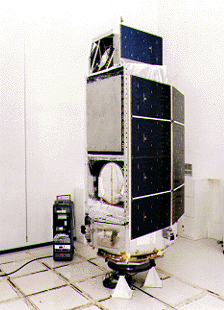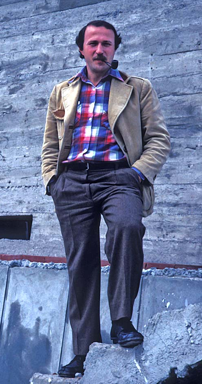Related Research Articles

X-ray astronomy is an observational branch of astronomy which deals with the study of X-ray observation and detection from astronomical objects. X-radiation is absorbed by the Earth's atmosphere, so instruments to detect X-rays must be taken to high altitude by balloons, sounding rockets, and satellites. X-ray astronomy uses a type of space telescope that can see x-ray radiation which standard optical telescopes, such as the Mauna Kea Observatories, cannot.

Astrophysics is a science that employs the methods and principles of physics and chemistry in the study of astronomical objects and phenomena. As one of the founders of the discipline, James Keeler, said, Astrophysics "seeks to ascertain the nature of the heavenly bodies, rather than their positions or motions in space–what they are, rather than where they are." Among the subjects studied are the Sun, other stars, galaxies, extrasolar planets, the interstellar medium and the cosmic microwave background. Emissions from these objects are examined across all parts of the electromagnetic spectrum, and the properties examined include luminosity, density, temperature, and chemical composition. Because astrophysics is a very broad subject, astrophysicists apply concepts and methods from many disciplines of physics, including classical mechanics, electromagnetism, statistical mechanics, thermodynamics, quantum mechanics, relativity, nuclear and particle physics, and atomic and molecular physics.

Rashid Alievich Sunyaev is a German, Soviet, and Russian astrophysicist of Tatar descent. He got his MS degree from the Moscow Institute of Physics and Technology (MIPT) in 1966. He became a professor at MIPT in 1974. Sunyaev was the head of the High Energy Astrophysics Department of the Russian Academy of Sciences, and has been chief scientist of the Academy's Space Research Institute since 1992. He has also been a director of the Max Planck Institute for Astrophysics in Garching, Germany since 1996, and Maureen and John Hendricks Distinguished Visiting Professor in the School of Natural Sciences at the Institute for Advanced Study in Princeton since 2010.

HEAO-1 was an X-ray telescope launched in 1977. HEAO-1 surveyed the sky in the X-ray portion of the electromagnetic spectrum, providing nearly constant monitoring of X-ray sources near the ecliptic poles and more detailed studies of a number of objects by observations lasting 3–6 hours. It was the first of NASA's three High Energy Astronomy Observatories, HEAO 1, launched August 12, 1977 aboard an Atlas rocket with a Centaur upper stage, operated until 9 January 1979. During that time, it scanned the X-ray sky almost three times
Electronic anticoincidence is a method widely used to suppress unwanted, "background" events in high energy physics, experimental particle physics, gamma-ray spectroscopy, gamma-ray astronomy, experimental nuclear physics, and related fields.

Jean Hebb Swank is an astrophysicist who is best known for her studies of black holes and neutron stars.

Cornelis A. "Neil" Gehrels was an American astrophysicist specializing in the field of gamma-ray astronomy. He was Chief of the Astroparticle Physics Laboratory at NASA's Goddard Space Flight Center (GSFC) from 1995 until his death, and was best known for his work developing the field from early balloon instruments to today's space observatories such as the NASA Swift mission, for which he was the principal investigator. He was leading the WFIRST wide-field infrared telescope forward toward a launch in the mid-2020s. He was a member of the National Academy of Sciences and the American Academy of Arts and Sciences.

The last of NASA's three High Energy Astronomy Observatories, HEAO 3 was launched 20 September 1979 on an Atlas-Centaur launch vehicle, into a nearly circular, 43.6 degree inclination low Earth orbit with an initial perigeum of 486.4 km. The normal operating mode was a continuous celestial scan, spinning approximately once every 20 min about the spacecraft z-axis, which was nominally pointed at the Sun. Total mass of the observatory at launch was 2,660.0 kilograms (5,864.3 lb).

The Small Astronomy Satellite 3 was a NASA X-ray astronomy space telescope. It functioned from May 7, 1975 to April 1979. It covered the X-ray range with four experiments on board. The satellite, built by the Johns Hopkins University Applied Physics Laboratory (APL), was proposed and operated by MIT's Center for Space Research (CSR). It was launched on a Scout vehicle from the Italian San Marco launch platform near Mombasa, Kenya, into a low-Earth, nearly equatorial orbit. It was also known as Explorer 53, as part of NASA's Explorer program.

OSO 7 or Orbiting Solar Observatory 7, before launch known as OSO H is the seventh in the series of American Orbiting Solar Observatory satellites launched by NASA between 1962 and 1975. OSO 7 was launched from Cape Kennedy on 29 September 1971 by a Delta N rocket into a 33.1° inclination, low-Earth orbit, and re-entered the Earth's atmosphere on 9 July 1974. It was built by the Ball Brothers Research Corporation (BBRC), now known as Ball Aerospace, in Boulder Colorado.

OSO 3, or Third Orbiting Solar Observatory was launched on March 8, 1967, into a nearly circular orbit of mean altitude 550 km, inclined at 33° to the equatorial plane. Its on-board tape recorder failed on June 28, 1968, allowing only the acquisition of sparse real-time data during station passes thereafter; the last data were received on November 10, 1969. OSO 3 reentered the Earth's atmosphere and burned up on April 4, 1982.

An X-ray astronomy satellite studies X-ray emissions from celestial objects, as part of a branch of space science known as X-ray astronomy. Satellites are needed because X-radiation is absorbed by the Earth's atmosphere, so instruments to detect X-rays must be taken to high altitude by balloons, sounding rockets, and satellites.

The history of X-ray astronomy begins in the 1920s, with interest in short wave communications for the U.S. Navy. This was soon followed by extensive study of the earth's ionosphere. By 1927, interest in the detection of X-ray and ultraviolet (UV) radiation at high altitudes inspired researchers to launch Goddard's rockets into the upper atmosphere to support theoretical studies and data gathering. The first successful rocket flight equipped with instrumentation able to detect solar ultraviolet radiation occurred in 1946. X-ray solar studies began in 1949. By 1973 a solar instrument package orbited on Skylab providing significant solar data.

Vahagn "Vahe" Gurzadyan is an Armenian mathematical physicist and a professor and head of Cosmology Center at Yerevan Physics Institute, Yerevan, Armenia, best known for co-writing "Concentric circles in WMAP data may provide evidence of violent pre-Big-Bang activity" paper with his colleague, Roger Penrose, and collaborating on Roger Penrose's recent book Cycles of Time.

Gerald Jay (Jerry) Fishman is an American research astrophysicist, specializing in gamma-ray astronomy. His research interests also include space and nuclear instrumentation and radiation in space. A native of St. Louis, Missouri, Fishman obtained a B.S. with Honors degree in physics from the University of Missouri in 1965, followed by M.S. and Ph.D. degrees in space science from Rice University in 1968 and 1970, respectively.

Kenneth John Frost was a pioneer in the early space program, designing and flying instruments to detect and measure X-rays and gamma-rays in space, primarily from the Sun. He was the first to suggest the use of an active scintillation shield operated in electronic anticoincidence with the primary detector to reduce the background from cosmic ray interactions, an innovation that made sensitive hard X-ray and gamma-ray astronomy possible. He was an American astrophysicist at Goddard Space Flight Center working as a civil servant for the National Aeronautics and Space Administration. During his career, he was the project scientist of the Solar Maximum Mission, principal investigator of six science instruments, the head of the Solar Physics Branch, and the associate director of Space Sciences.

Hakkı Boran Ögelman was a Turkish physicist and astrophysicist. He was an expert on gamma ray astronomy, the physics of neutron stars, and solar energy and worked on several key topics in modern astrophysics. He made many contributions to high energy astrophysics. In his early professional career he engaged in the SAS-II Small Gamma Ray Astronomy Satellite experiment development, data analysis, and first detection and imaging of our universe in gamma rays with his NASA colleagues, as well as in other fields of physics. His main interests in the field of astrophysics were the study of gamma ray astronomy and compact objects such as neutron stars and pulsars. Ögelman worked at NASA Goddard Space Flight Center, Middle East Technical University (METU) in Ankara, Turkey, Çukurova University in Adana, Turkey, Max Planck Institute (MPI) at Garching, Germany and the University of Wisconsin.

Elena Aprile is an Italian-American experimental particle physicist. She has been a professor of physics at Columbia University since 1986. She is the founder and spokesperson of the XENON Dark Matter Experiment. Aprile is well known for her work with noble liquid detectors and for her contributions to particle astrophysics in the search for dark matter.

Dr. Martin C. Weisskopf until his retirement from NASA in at the end of May, 2022, was project scientist for NASA's Chandra X-ray Observatory and Chief Scientist for X-ray Astronomy in the Space Sciences Department at NASA's Marshall Space Flight Center in Huntsville, Alabama. He was also the Principal Investigator of the Small Explorer mission the Imaging X-ray Polarization Explorer (IXPE).
Allan Stanley "Bud" Jacobson was an American astrophysicist, known for his pioneering research in high-resolution gamma-ray spectroscopy.